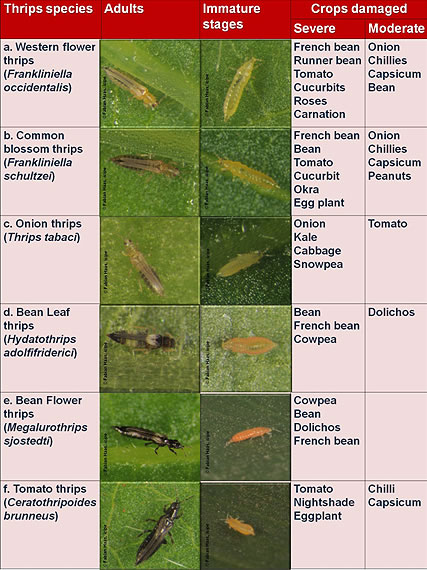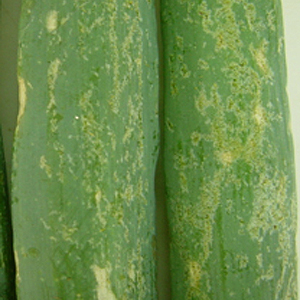Amin PW, Reddy DVR, Ghanekar AM & Reddy MS (1981). Transmission of Tomato Spotted Wilt Virus, the causal agent of bud necrosis of peanut, by Scirtothrips dorsalis and Frankliniella schultzei. Plant Disease 65 (8): 663-665
Birithia R, Subramanian S, Pappu HR, Sseruwagi P, Muthomi JW & Narla RD (2011). First report of Iris Yellow spot virus infecting onion in Kenya and Uganda. Plant Disease 95: 1195
Birithia R, Subramanian S, Villinger J, Muthomi JW, Narla RD & Pappu HR (2012). First report of Tomato yellow ring virus (Tospovirus, Bunyaviridae) infecting tomato in Kenya. Plant Disease 96: 1384
Brittlebank, CC (1919). Tomato diseases. J Agric Vicotria
17: 231-235
Dugje IY, Omoigui LO, Ekeleme F, Kamara AY & Ajeigbe H (2009). Farmers- Guide to Cowpea Production in West Africa. IITA, Ibadan, Nigeria. 20 pp
German TL, Ullman DE, Moyer JW (1992). Tospoviruses: Diagnosis, molecular
biology, phylogeny, and vector relationships. Annu Rev Phytopathol 30: 315–348
Jackai LEN & Daoust RA (1986). Insect Pests of Cowpeas. Annual Review of Entomology 31:95-119.
Jones DR (2005). Plant viruses transmitted by thrips. European Journal of Plant Pathology 113: 119-157
Milne, RG, Francki RI (1984). Should tomato spotted wilt
virus be considered as a possible member of the family Bunyaviridae? Intervirology
22: 72-76
Moritz G, Kumm S, Mound LA (2004). Tospovirus
transmission depends on thrips ontogeny. Virus Research 100: 143-149
Mound LA (1996). The Thysanoptera vector species of Tospoviruses. Acta Horticulturae 431: 298-309
Nagata T, Inoue-Nagata AK, Smid HM, Goldbach R, Peters D (1999). Tissue tropism related to vector competence of Frankliniella occidentalis for tomato spotted wilt tospovirus. J Gen Virol 80 (Pt 2): 507-515
Nyasani JO, Meyhöfer R, Subramanian S & Poehling H-M (2012). Effect of intercrops on thrips species composition and population abundance on French beans in Kenya. Entomologia Experimentalis et Applicata 142: 236 - 246
Pittman, HA (1927). Spotted wilt of tomatoes. Prelimary
note concerning the transmission of the "spotted wilt" of
tomatoes by an insect vector (Thrips tabaci Lind.). Aust J Counc
Sci Ind Res 1: 74-77
Ramkat RC, Wangai AW, Rapando PN & Lelgut DK (2008). Cropping system influences Tomato spotted wilt virus disease development, thrips population and yield of tomato (Lycoperscion escullentum). Journal of Applied Biology, 153, 373-380
Rapando P, Wangai AW, Tabu I & Ramkat R (2009). Variety, mulch and stage of inoculation effects on incidence of tomato spotted wilt virus disease in cucumber (Cucumis sativus L.) Archives of Phytopathology and Plant Protection 42: 579 - 586
Riley DG, Joseph SV, Srinivasan R & Diffe S (2011). Thrips vectors of tospoviruses. Journal of Integrated Pest Management 1(2): DOI:10.1603/IPM10020
Samuel G, Bald JG, Pittman HA (1930). Investigations
on "spotted wilt" of tomatoes. Australia Commonw Counc Sci Ind Res
Bull No. 44
Schreiter G, Butt TM, Beckett A, Vestergaard S, Moritz G (1994). Invasion and development of Verticillium lecanii in the western flower thrips Frankliniella occidentalis. Mycol. Res. 98(9): 1025-1034
Sin S-H, McNulty B, Kennedy GG, Moyer, JW (2005). Viral genetic determinants for thrips transmission of Tomato spotted wilt virus. PNAS 102, 5168-5173
Ullman DE (1996). Thrips and Tospoviruses: Advances and future directions. Acta Horticulturae 431: 310-323
Ullman DE,
Cho JJ,
Mau RFL,
Hunter WB,
Westcot DM,
Custer DM (1992): Thrips-Tomato Spotted Wilt Virus interactions:
Morphological, behavioral and cellular components influencing thrips transmission.
Advances in Disease Vector Research 9: 195-240
Ullman DE, Meideros R, Campbell LR, Whitfield AE, Sherwood JL, German TL (2002). Thrips as vectors of tospoviruses. Advances in Botanical Research 36:113-140
Ullman DE, Whitfield AE, German TL (2005). Thrips and tospoviruses come of age: Mapping determinants of insect transmission. PNAS 102: 4931-4932
Van de Wetering F, Goldbach R,
Peters D (1996). Tomato spotted wilt tospovirus ingestion by first instar larvae of Frankliniella occidentalis is a prerequisite for transmission. Phytopathology 86: 900-905
Wangi AW, Mandal B, Pappu HR & Kilonzo S (2001). Outbreak of tomatoes spotted wilt virus in tomato in Kenya. Plant Diseases, 85: 1123
Whitfield AE, Ullmann DE, German TL (2005). Tospovirus-Thrips
interactions. Anny Rev Phytopathol 43: 459-489
----
Web links
Tomato spotted wilt virus
Mound´s Thysanoptera pages
Thysanoptera Checklist
ICIPE Thrips survey sites
UNI Halle & Thrips sites
Thrips of California















